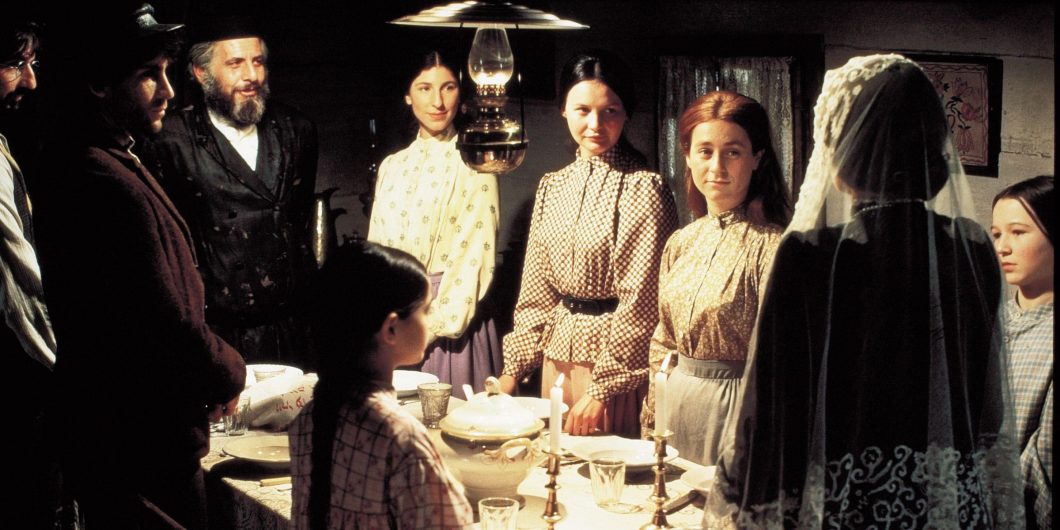One of the thinkers Steve Bannon says he admires, Julius Evola, despised the United States and everything it stood for.
Traditional Limits
The opening number of the classic stage musical and film Fiddler on the Roof is “Tradition.” Singing over a swaggering klezmer beat, the inhabitants of the shtetl Annatevka describe the sources of order and meaning in their difficult but far from oppressive way of life. Prayer, study, family, work. These are pillars of continuity that sustain Eastern Europe’s Jews as the world changes around them.
Although he is an English Catholic, Tim Stanley cannot resist invoking this memorable performance in Whatever Happened to Tradition? Reviewing the travails that culminate in the Jews’ abandonment of Annatevka, Stanley hails tradition as a kind of portable anchor that allows adherents to secure themselves anywhere. “They leave the village,” he writes “but they take their traditions with them, and that way they remain true to themselves—as Jewish in America as they were in Russia, never completely lost because when you carry your home with you, it is never far to hand.”
This is a reassuring conclusion that supports Stanley’s gentle, humane defense of gratitude, continuity, and loyalty in a time and society that disdain them. But it is also a greater concession to the spirit of our age than Stanley admits.
As the scholar Ruth Wisse noted in an essay for Mosaic, the Broadway and Hollywood productions of Fiddler depart from the literary source. In Yiddish writer Sholem Aleichem’s tales of Tevye the Dairyman, which don’t share the title inspired by Marc Chagall’s 1912 painting, tradition is far more rigorous—and disturbing—to modern audiences than in the dramatic version.
Both narratives revolve around the marriage of Tevye’s daughters to increasingly unsuitable husbands, culminating in the youngest’s elopement with a Ukrainian and her conversion to Christianity. Hollywood’s Tevye reconciles himself to this calamity. Aleichem’s Tevye, by contrast, insists his daughter is dead to him and performs the ritual of mourning that was then common for Jews who left the community. Aleichem doesn’t leave the matter on this tragic note: eventually, Hava repents of her mistake, leaves her husband, and returns to her Jewish home. But the implication is the opposite of the familiar moral. Instead of romantic attachment triumphing over filial and religious duty, duty triumphs over love.
There’s a related difference in the source and the dramatic treatments of America, where many inhabitants of Annatevka seek new lives after a devastating pogrom. Although the film is tinged with nostalgia for the shtetl, it presents this move as fundamentally a change for the better. And that’s how much of its American Jewish audience would have experienced it. By the final third of the 20th century, when Tevye made his way to stage and screen, American Jews were more prosperous, confident, and influential than their forebears at any other place or time in the long diaspora.
Yet Aleichem did not agree that America is “the promised land,” as the film suggests and Stanley writes. Although he made the same journey to New York as Tevye, he was also a Zionist who hoped and worked for Jewish settlement in the Biblical promised land. America was beautiful to Aleichem and his characters. But it was not home.
There are good reasons to worry about the viability of tradition in the new world. Many of Tevye’s fears have been realized in the United States. Rising intermarriage, declining observance, and the attenuation of religious education have transformed large portions of the Jewish community into a mostly symbolic “identity” group. As a heavily assimilated, minimally observant Jew myself, I can’t protest too strongly against these developments without contradicting my own revealed preferences. But I also don’t imagine that the mostly secular descendants of the great migration that included Tevye are as Jewish as our ancestors were. We are more like Hava’s Christian Ukrainian husband Fyedka, who reproaches Tevye for his stubborn, irrational attachment to his people and their tradition.
It may seem unfair to direct these challenges at Stanley, who acknowledges that Fiddler addresses “the ambiguities of cultural conservatism” rather than making a clear-cut case. But I think that the film’s indelible connection to “tradition” indicates the limits of the concept. Common sense suggests that durable traditions will be immediately rewarding and easy to adapt. Jewish history indicates the opposite: the traditions most likely to stick around are the hard ones. One of the dilemmas of modern Judaism is that the demanding features that helped sustain Jewish tradition through so many centuries and calamities also make it difficult to revive once the chain of transmission is interrupted. It is very difficult to become traditionally observant unless you are habituated to it almost from birth.
It is easy enough, by contrast, to make the case for tradition in general. Closer attention to Tevya the Dairyman reminds us that there is no such thing. Rather than defending tradition as such, he upholds, with greater or lesser success, a Yiddish-based Ashkenazi folk culture. He would have been scandalized by some of Aleichem’s Zionist friends, who abandoned conventional religious practices even as they pursued a return to the Biblical promised land, and perplexed by the equally Jewish but strikingly different Sephardic culture of the Mediterranean. Which traditions are good and which bad? Which essential and which dispensable? Tevye confronts the trials of his life from within a particular tradition, but would not be much help in comparing them.
Even as he rejects the cultural predisposition against tradition that distinguishes the modern West, Stanley endorses its institutional consequences.
Stanley, who’s trained as a historian and published widely as a journalist, takes a broader view. The book ranges nimbly from medieval Europe to the early American republic to the 21st-century Middle East—and beyond. As a result, it discusses a wide range of traditions, many in tension with one another. Should traditions draw boundaries with outsiders, like the Yazidis of Iraq, or strive to reduce them, like some elements of Hinduism? Should they embrace industrial technology, like the Meiji Restoration in Japan, or resist it, like the Arts and Crafts movement in Britain? Does the institution of private property promote tradition or inhibit it? There are powerful arguments on both sides of these questions. But appeals to tradition per se provide few answers.
Nor does Stanley provide much guidance about the appropriate means of upholding tradition. He is rightly skeptical of efforts to revive the past through centralized coercion. Confronting an example that’s become even more relevant since the book was published earlier this year, Stanley notes that Russia’s post-communist experiment in “state-sponsored tradition” has had mixed success at best. Although three-quarters of the Russian population identify as Orthodox Christians, only around 6% participate in organized worship on a weekly basis. Recent efforts by the Patriarch Kirill to rally support for the invasion of Ukraine strengthen the impression that the result is a noxious merger of church and state that more than a little resembles the tsarism that threatened Tevye long ago.
It’s less morally or politically risky to defend individual choices in favor of traditional communities and beliefs, whether the Jewish ba’al teshuvah, who makes the successful return to rigorous observance, or Stanley’s own entry to the Catholic Church. For many of those who make them, these decisions are the point of entry to a more beautiful, rewarding, and fundamentally dignified existence. In some cases, they’re literally life-saving. Stanley is right to defend them against their cultured despisers.
Even if they’re a choice for tradition, though, these are still choices. For that reason, they don’t really challenge the presuppositions of modern Western society, despite their apparently atavistic quality. Early in the book, Stanley states that “the primary villain in my story is liberalism, the political inheritance of the Enlightenment, which has created a state of permanent rebellion against the past.” But the freedom to choose among ways of life—particularly as manifested in religious communities—is the generative principle of liberal order. Even as he rejects the cultural predisposition against tradition that distinguishes the modern West, Stanley endorses its institutional consequences. Despite his affection for the British monarchy, he says nothing to challenge the secular rule of law, equal status among citizens, or the freedom to associate and to practice and promote a dissenting vision of the good life.
Yet these are precisely the goals associated with the emergence of liberalism in the 18th and 19th centuries. The reason they can be taken for granted now is that what were once revolutionary demands have become a tradition of their own, imperfect and confusing like all the others. In that respect, a comprehensive rejection of liberalism in the name of tradition is less of a return to the past than its rejection. It is to Stanley’s credit that he disclaims that enterprise, which appeals in different ways to the conservative revolutionaries of the right and to the “woke” moralists of the left. But that leaves him as precariously balanced as…a fiddler on the roof.



